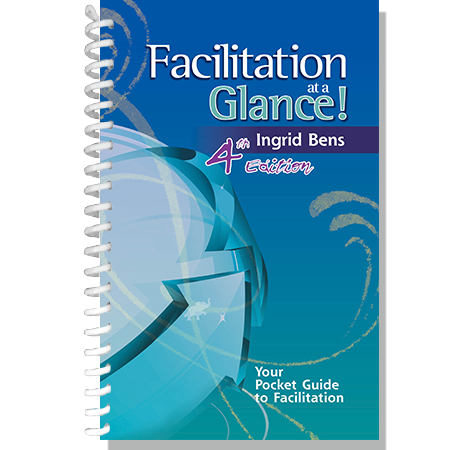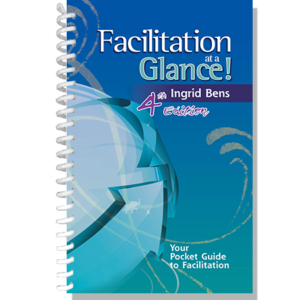Description
Take a look at the Table of Contents and selected pages below.
It is impossible to be part of an organization today and not attend meetings. Staff meetings, project meetings, task force meetings, planning and coordinating meetings…..the list is endless. The worst thing about many of these meetings is that they’re poorly run and waste valuable time. Today, there’s been a growing recognition that effective meetings happen when proper attention has been paid to the process elements and when proceedings are skillfully facilitated. We are now spending so much time in meetings and being asked to achieve so many important goals in teams that there’s a growing need for skilled facilitation throughout our organizations and our communities. Facilitation is fast becoming a core competency for anyone who leads a team, manages a project, heads up a committee, or manages a department. To get the most from people today, leaders have to know how to create buy-in, generate participation, and empower people. To keep pace, today’s leaders need to be coaches, mentors, and teachers. At the core of each of these new roles is the skill of facilitation and this pocket guide is your essential resource for this expertise.
Facilitation at a Glance! is a best seller and in this new edition all of the features that made past editions so popular have been retained. Every chapter has been further enhanced and a number of new elements have been added:
- Understanding Facilitation – Manage the process not the content. Use language of facilitation. Understand best and worst facilitation practices.
- Effective Questioning – What to ask, why, how and how might people respond. Question types, question formats, question bank, and question pointers.
- Facilitation Stages – Assessment and Design. Feedback and Refinement. Final Preparation. Starting a facilitation, during a facilitation, and ending a facilitation. Follow up.
- Who Can Facilitate – Internal vs. External. Meeting Leadership. Facilitation strategies for leaders. Role challenges and facilitating colleagues.
- Knowing Your Participants – Conducting an assessment. Group assessments. Comparing teams to groups. Getting a group to act like a team.
- Creating Participation – Anticipate Potential Barriers. Create the conditions for full participation. Clarify topics, create buy-in and identify organizational support.
- Effective Decision Making – Traits of effective decision making. The four types of conversations. The four levels of empowerment. Decision making paradigms, options, poor decisions and things to watch for.
- Facilitating Conflict – Comparing and facilitating arguments and debates. Steps in managing conflict. The five conflict options. Preventing conflict. Interventions. Dealing with resistance. Common pitfalls.
- Meeting Management – Meetings that work. Our meetings are terrible. Meeting behaviors symptoms and cures. Meeting process notes. Balancing meeting roles. Status Update meetings. Meeting surveys. Virtual meetings. Meeting best practices.
- Process Tools For Facilitators – Appreciative review, visioning, gap analysis, decision grid, troubleshooting, exit survey, needs and offers dialogue, and gallery walk.
- Meeting Design Template – Steps in meeting design, potential pitfalls, meeting components.
The new innovative chapter on the Art of Questioning helps facilitators identify the right questions to ask in a wide variety of situations. It contains a unique Question Bank with over 150 tried and tested questions that will help with all kinds of situations, such as establishing parameters, behavioral norms, expectations, uncovering issues, creative thinking, resistance to change, commitment, clarity, perspective etc. The chapters on Decision Making and Conflict Management have had major updates to add important new techniques. The chapter on Meeting Management now features process notes for the all important Status Update Meeting and “at a glance” charts describing facilitator best practices, before, at the start, during, and at the end of every meeting.
Ingrid Bens, the author, is a nationally known consultant/trainer, and continues to enlighten us with an updated and comprehensive view of the role of the facilitator and the essential core practices of facilitation and meeting management that are always in play.
With this new edition, Facilitation at a Glance! increases its importance as a must-have resource for anyone who plans meetings or leads teams.
ISBN: 978-1-57681-183-2
“Facilitation at a Glance! is a must have tool for anyone who leads teams, manages projects or runs meetings, regardless of the industry. It’s chock-full of tools that work in real-world situations: tools that help you to gain buy-in, overcome resistance and manage ineffective behaviors. No consultant or manager should be without their own copy!”
Roberta Caldwell, MA,
Strategy and Change Consultant
“If you’re serious about facilitation, then this is THE book to read, read again and use every day as a reference. And don’t let the small format fool you: this book has all the tools, techniques and practical tips you will ever need.”
Adriano Pianesi, Principal Partner of Leadersh1p.com
Author of Teachable Moments of Leadership.
“This compact facilitation guide is a must have for lean leaders who are coaching shop floor teams. It gives them the practical tools they need to plan strategy, manage change and lead Kaizen events.”
Dan Prock, M.Eng., PhD,
Author of The Sensei Way




Rebekah W. –
This book has been a great resource for me, especially as I’ve been a facilitation consultant for many years. There were dozens of additional insights that I was able to pick up to use on site with my customers. The Question Bank is a great addition as well from previous versions. Good reference book overall.
David V. –
I have used several of the Memory Jogger series over my many years in business and have always found them to be very useful tools to keep near my desk. The latest Facilitation at a Glance book is no exception. It is well written and to the point, a helpful resource for those new to the field and for experienced practitioners…. would recommend to others.
Denise R. –
Great book. Just note that there are two sizes depending on your needs. The default is the “pocket guide” with smaller fonts/graphics, while the larger “desktop guide” is slightly larger. I keep the larger one in my desk and the smaller one in my bag while traveling to customer sites. Overall an easy to use book with all the information I need!
Robert J. –
Was given this book as part of a training course. I reference this book more after the course than the actual materials. Great resource.